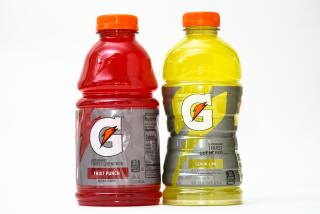The Downsizing of Watermelons
- Share via
FIREBAUGH, Calif. — In a world of super-size portions, something is actually shrinking.
That’s apparent in a sun-blasted San Joaquin Valley field of curiously small and rounded watermelons that were purposely bred to match the declining size of the average American household.
As a result of that unusually demographic-driven agriculture, the seedless mini-watermelons are about the size of cantaloupes and usually weigh 4 to 6 pounds. They are easier to carry and cut than their behemoth cousins that dominate so many American picnics and parties. The little melons also offer an alternative for anyone, particularly singles or childless couples, willing to pay a premium to avoid tossing leftovers.
“I think it’s more attractive to the customers, because people don’t have to waste part of the melon. They can eat it all, a full melon at one time,” said field manager Arturo Sanchez in the vine-covered tract, about 35 miles west of Fresno, where crews pick and box upward of 300,000 minis a day in the 95-plus-degree September heat.
Sanchez works for Dulcinea Farms, an Orange County-based firm that is one of the pioneers in the rising mini-melon industry. Dulcinea’s PureHeart brand is just four years out of the hybrid seed laboratory but is grabbing shelf space in stores and taking over fields in California, Arizona and Mexico previously planted with bigger melons or cotton.
Other companies also compete in the burgeoning mini-melon market under such brand names as Sundia and Bambino.
The National Watermelon Promotion Board said retail scanning shows that sales of all brands of seedless minis rose from about 13.7 million pounds in 2003 to about 82.6 million pounds last year. Sales are about 25% higher so far this year.
That represents only about 6% of all watermelon sales but is “explosive growth” because minis were not widely available before 2003, said Bill Winsemann, the board’s director of industry affairs.
Such commercial promise is why scientists and farming experts at the University of California’s Cooperative Extension have been testing 10 varieties -- with such names as Extazy, Liliput and Mini Triploid 2618, and a Dulcinea mini whose formal horticultural title is Petite Perfection.
The trials, from crops in the Fresno and San Diego areas, started in 2003 and will last several more years for definitive answers on such issues as yield, flavor, sugar content and flesh coloring. UC wants to provide objective advice as a public service on where, when and how best to plant them in the various climate zones around the state and to avoid some of the disappointing results that have occurred with new agricultural products in the past.
Besides such scientific trials as measuring sugars on the Brix scale and sizing the rinds by the millimeter, old-fashioned taste tests are held. Visitors to the extension’s public field days have voted on flavor and textures on a scale of from “blah to outstanding.” But recent plans for a San Diego taste test were abandoned after a farmer mistakenly sold the would-be samples -- perhaps a symptom of overall popularity.
Richard Molinar, a cooperative extension farm advisor affiliated with UC Davis who is working on the tests, noted that vegetable and fruit growers have always looked for ways to boost sales, often by improving crop yield and shelf life. But going after a perceived demographic demand, he said, “that’s unusual.”
The minis “are never going to replace the larger melons, but it is a trend for a particular clientele group or consumers like the small family or single person. They want to get it cold, eat it and be done with it,” he said.
Some of the minis, as the UC researchers noted, require extra care. Their thin rinds may bruise easily and they need refrigeration at first, something bigger melons often don’t get.
That’s why the melons harvested for Dulcinea are boxed in the field, quickly hauled to a giant cooling warehouse about 20 miles south and chilled to around 50 degrees before refrigerated trucks move them to retailers. Shops don’t usually chill them.
One recent morning 11 crews -- about 200 people -- begin their day around 8 a.m., working under a nearly cloudless sky until just after noon. To a visitor, the crop size seems astonishing: about 20,000 cartons, or about 140,000 minis. And that is about half of the harvest of a previous day, Sanchez said.
Melon cutters, the most skilled of the farmhands, scour the green vine rows for telltale signs of melon ripeness, such as sharply defined vertical lines on rinds, a lightening of the green skin and a flattening stem. They cut the ready ones from the vines and keep moving.
Next comes a rolling factory. Tractors slowly pull flatbeds and, attached to the rear, a tented work platform. Pickers lift the ripe melons onto an eye-level shelf from which other workers, mainly women, size and label them and place them in cardboard cartons roomy enough for six to eight melons. Those headed to Costco are paired in plastic netting bags, bearing price scanning codes.
Minis’ cultivation and marketing dovetail with a population trend. According to the Census Bureau, households with just one or two people rose from about 43% of all households in 1965 to 59% last year. In the same period, the average number of people in American households dropped from 3.29 to 2.6.
The demographic slice includes shoppers such as Ardy Kassakhian, 30, who recently was picking up a Dulcinea mini-melon at the Whole Foods in Glendale, where he is the elected city clerk. They were selling for 99 cents a pound, compared with 59 cents a pound for the large melons. “Just enough for two people,” said Kassakhian, who lives with his brother. He described the minis as being as sweet as the biggies.
Matt Becker, Costco’s national assistant buyer for fresh foods, said the warehouse chain began testing sales of minis two years ago with “very positive” feedback. In the last fiscal year, Costco sold about 2 million pairs, up from about 250,000 pairs the previous cycle, he said.
Watermelons had been trending smaller and sold in pieces for a while. Seeded minis had been available in Asia and Europe.
Breeders for Dulcinea’s parent company, the Swiss-based agribusiness giant Syngenta, set out seven years ago to create a personal-sized seedless and sweet melon that would have a thin rind and could be pollinated by bees. The hybridization resulted in such a different variety that its female parent was awarded a U.S. patent.
Dulcinea Farms went from testing minis on two acres near Sacramento five years ago to current contracts with growers on about 1,400 acres in Central California and 3,300 acres more around the U.S., Mexico and Central America, officials said. It is exploring places such as Brazil to maintain supplies during North American winters.
The Dulcinea minis grow from seeds in greenhouses for about a month. Seedlings about 6 inches high are then mechanically planted and cultivated with drip irrigation for two months or so. The final cuttings can take place at the end of September.
“We’re changing the paradigm in agriculture,” Dulcinea Farms’ general manager Keith Kato said from his office in Ladera Ranch.
Typically, growers had the most influence on crop choices, based on water use and disease resistance, even if those didn’t match shoppers’ expectations, he said.
Responding to the consumer “is fairly revolutionary in seed development and agriculture,” he said.
*



